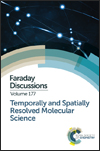On the photophysics of butadiyne bridged pyrene–phenyl molecular conjugates: multiple emissive pathways through locally excited, intramolecular charge transfer and excimer states†
Abstract
The present work describes the photophysical properties of a group of butadiyne bridged pyrene–phenyl molecular hybrids having different substitutions with varying donor and acceptor abilities. In addition to emission from the locally excited (LE) state originating from the pyrene moiety, intramolecular charge transfer (ICT) emissions were observed in molecules with donor–acceptor character. The positions of the ICT emission maxima varied over a wide range of wavelengths (475–600 nm). Pyrene behaved as a donor when a strong acceptor group (–CN) was attached to the phenyl ring and it behaved as an acceptor when the phenyl group contained a strong donor group (–NMe2). In mixed aqueous solvents at higher percentages of water (80–99%), the derivatives showed emissions from the aggregate state in addition to the LE and ICT states. Emissions from the aggregate states of the derivatives were centred in the range 510–560 nm. The aggregate state emissions were found to originate from static excimers involving pyrene moieties. A detailed structure–property relationship of the butadiynyl derivatives was revealed in this study.
- This article is part of the themed collection: Temporally and Spatially Resolved Molecular Science

 Please wait while we load your content...
Please wait while we load your content...